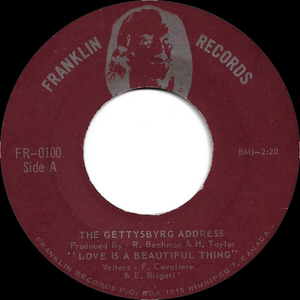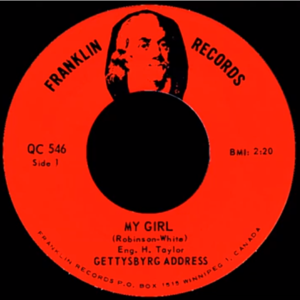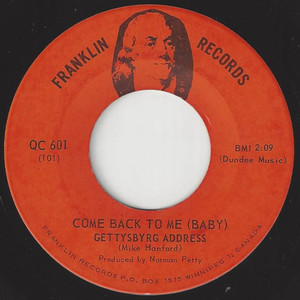Gettysbyrg Address
Websites:
No
Origin:
Winnipeg, Manitoba, 🇨🇦
Biography:
One of Winnipeg’s early favourite local groups, Gettysbyrg Address was formed in 1967 by vocalist/keyboardist Mike Hanford. The first incarnation of the group was rounded out by guitarists Kurt Winter and Orest Andrews, Bill Wallace on bass, and drummer Craig Hamblin.
Initially Hanford wanted to carry on the name of his previous group, The Shondels, who recorded four singles prior to breaking up in ’66. When he couldn’t talk the band’s original founder into giving up the name, Hanford came up with Gettysbyrg Address from the famous speech by Abraham Lincoln following the Civil War, simply altering the name.
They played the local area circuit and hit the road, making every stop on the prairies while gaining the attention of Frank Weiner, president of Franklin Records, a local Winnipeg label. Their first single in the fall of ’67 called “Love Is A Beautiful Thing” b/w “Keep Your Hands Off My Baby” was produced by Randy Bachman and Harry Taylor. After it reached #3 on the Canadian chart, they followed up before the end of the year with a couple of Motown covers – The Temptations’ “My Girl” and Phil Spector’s “Be My Baby.” They continued on the road and opened for the likes of The Guess Who, Paul Revere & The Raiders, The Byrds, Johnny Rivers, Gerry & The Pacemakers, and Herman’s Hermits.
By the spring of ’68 Hamblin was replaced behind the drumkit by Ken Hordichuk. They were hooked up with famed producer Norm Petty (Wes Dakus & The Rebels, Southbound Freeway, Barry Allen), in his Clovis, New Mexico studio, and released a pair of original tune as their third single, “Come Back To Me Baby” b/w “You’ve Got To Let Me Know.”
Shortly after, Andrews left the group and was replaced by Greg Leskiw. Tours across western Canada continued until Hanford quit about a year later, effectively ending the band’s tenure, as everyone else soon followed him out the door. Leskiw formed the short-lived Logan Avenue with Wallace and Winter.
The band remained in limbo until Weiner convinced those three to drop that act and reform Gettysbyrg Address in late 1969. Adding Hermann Fruhm on keyboards and drummer Richard Torrance, they tried to pick up where they’d left off and found some gigs around the prairies. They recorded one final single, Leskiw’s “Baby True” for a Franklin compilation album the following spring, and then again as a single on the Jazzman Records label that summer. It wasn’t long however before the band called it quits for good and everyone went on to other projects.
Most members at one time or another would later be involved in either The Guess Who, or at least one of the other spin-offs of the band. Winter and Wallace both also played with Brother first, Leskiw formed Wild Rice for a couple of months before joining TGW, then formed Crowcuss with Fruhm. He and Leskiw then formed Mood Jga Jga for one album (then a reunion album in 1997), before Leskiw then formed Les Q. After he’d left TGW, Wallace then joined Leskiw in Kilowatt. Leskiw . Hanford also eventually joined a short-lived version of TGW in the mid ’80s, then moved to BC and became a songwriter, most notably for Mainline. Winter passed away in 1997 from kidney failure.
In 2008, Super Oldies Records released a compilation album entitled THE BEST OF FRANKLIN RECORDS – 1967 – 1972, containing all seven Getysbyrg Address songs that appeared on 45. A year later, they released another compilation called FROM CANADA TO CLOVIS, that included the two tracks released as their third single, as well as a pair of unreleased songs – covers of The Beatles’ “Ticket To Ride” and Bobby Bland’s “Stormy Monday Blues.”
Bill Wallace
Orest Andrews
Kurt Winter
Mike Hanford
Graig Hamblin
December 14, 1997 – Kurt Winter was born Kurt Frank Winter in Winnipeg, Manitoba, on April 2, 1946. He attended Daniel McIntyre Collegiate Institute. Winter commenced the development of his music career with a number of Winnipeg bands, including Gettysbyrg Address (1967, with later Guess Who bass player Bill Wallace), The Fifth (1968, with drummer Vance Masters) and Brother (late 1969, with Wallace and Masters). Brother was regarded as Winnipeg’s first supergroup, playing all original material, the live shows of which were greatly admired by vocalist Burton Cummings.
He was not involved in the writing of “American Woman”, the Guess Who’s international superhit in 1969.
Kurt Winter
At the invitation of Cummings, Winter joined The Guess Who in June, 1970, along with guitarist Greg Leskiw, who had also succeeded Winter as a guitarist in Gettysburg Address. The two guitarists replaced Randy Bachman, who had abruptly left The Guess Who to form Bachman, Turner, Overdrive. Winter is solely credited with writing the hit singles “Bus Rider” and “Hand Me Down World”, both of which were hits for The Guess Who, but which had been composed while Winter was with the band Brother.
Songs written by Brother were collectively written by Winter, Wallace and Masters. Winter also co-wrote a number of songs with group leader Burton Cummings, including the hits “Hang on to Your Life”, “Rain Dance”, and “Runnin’ Back to Saskatoon” and also co-wrote “Clap for the Wolfman” with Cummings and Bill Wallace.
At the age of twelve he was smitten with the guitar and soon found his lifelong calling. A gifted lead guitarist, Kurt served his apprenticeship in a number of local bands including The Flares, The Ramrods, The Cavaliers, The Syndicate, and Sons and Lovers before forming the Gettysburg Address with future Guess Who bass player Bill Wallace in late 1966. Within a matter of months the Gettysbyrg Address became one of the top bands in the city and recorded three singles on the local Franklin label. But by 1968 Kurt was chafing at simple pop music and sought to emulate his heroes Frank Zappa and Jimi Hendrix. After a short stint with The Fifth, in early 1970 Kurt, Bill Wallace and Vance Masters formed what is regarded as Winnipeg’s first supergroup, Brother. Boasting all-original material Brother’s shows were stunning and quickly caught the eye of Guess Who singer Burton Cummings. “Brother were the best live band I ever saw in this city,” Cummings insists. On May 16, 1970 with their song million-selling American Woman single #1 worldwide, guitarist Randy Bachman abruptly quit the Guess Who and Kurt along, with guitarist Greg Leskiw, was invited to join the group. He accepted two weeks later and shouldered the unenviable task of stepping into an immensely popular group already at the top and managed to maintain that level of success over the next four years.
Coming onboard with a backlog of songs, the Guess Who recorded Kurt’s Brother compositions Hand Me Down World along with Bus Rider, Do You Miss Me Darlin’ and Rock & Roller Steam. He began a successful collaboration with Burton Cummings that yielded further hits with Hang On To Your Life, Broken, Rain Dance, Heartbroken Bopper, Runnin’ Back To Saskatoon, Follow Your Daughter Home, Guns Guns Guns, and Clap For The Wolfman. “Kurt and I became instant friends,” notes Cummings, “and we wrote together because it was fun. Kurt and I would party and write songs.” By the end of 1970 the Guess Who had earned over $5 million from record sales and concerts making them the most successful Canadian band up to that point. With his first flush of money, Kurt bought a modest home on Chevrier Boulevard in Fort Garry, pictured on the back cover of the Guess Who album So Long Bannatyne, where he resided until his death in 1997.
Despite the dozens of gold records, recording sessions in Hollywood, TV appearances on The Midnight Special and world tours, Kurt never embraced the rock star lifestyle, a fact that endeared him to his loyal legion of fans who even took to dressing like their hero in Garnet Amplifier sweatshirts and stripped slacks and calling out to him at concerts across North America. On his first Guess Who tour Kurt wore the same clothes night after night. “I didn’t have any other clothes,” he admitted. “I didn’t even own a suitcase.” Kurt always boasted that his biggest extravagance was the purchase of a vintage white Cadillac. In all others areas of life, Kurt retained his amiable down home no-frills charm. A self-styled ‘meat and potatoes guitarist’, his guitar solos were highly regarded by other players in the rock music field and Kurt was honoured with induction into the Playboy top guitarists poll for his searing slide guitar work on Star Baby. Among the Guess Who entourage, Kurt was famous for his card playing and would while away the long hours on plane trips or in hotels in marathon games of poker or blackjack.
Kurt was featured on a number of Guess Who albums including Share The Land, The Best of The Guess Who, So Long Bannatyne, Rockin’, Live At The Paramount, Artificial Paradise, #10, The Best of The Guess Who Vol. 2, and Road Food before exiting the band in June of 1974 as Clap For The Wolfman was climbing the charts. Citing exhaustion from the rigours of the road, Kurt spent several months either relaxing at home or golfing, but was lured back into the music world by friends Vance Masters and Duncan Wilson who, with Kurt and other local players, formed Bubbles then Papa Pluto featuring many of Kurt’s own songs. In 1977, former Guess Who members Jim Kale and Don McDougall resurrected the Guess Who name and invited Kurt to join them along with Vance Masters and Dave Inglis. Kurt remained for a year and a half contributing his songs and unique guitar style to two albums, Guess Who’s Back and All This For A Song. Facing the task of going out on the road, Kurt opted to step aside. “I just wanted to have fun and make a little money,” he insisted. “I didn’t want to take it too seriously so I just hung up my skates.” Royalties from his many Guess Who recordings provided Kurt and his wife Vikki with a modest income, enough to keep him, as he often said, in cigarettes and beer. Attempts by Burton Cummings to revive their successful songwriting partnership in the 1980s were rebuffed as Kurt continued to enjoy his retirement in the company of family and friends. He appeared onstage in June of 1987 at the Shakin’ All Over: Winnipeg Bands and Fans Reunion alongside Cummings, Bachman and ex-Winnipegger Neil Young and for the last time in February of 1994 reunited with the other Brother members for a brief yet well-received set.
Health problems plagued Kurt in later years, the result of decades of alcohol abuse. He was hospitalized in 1996 for a benign brain tumor but recovered enough to travel to Toronto in November of 1997 to accept an award from SOCAN (Society of Composers, Authors and Music Publishers) for over 100, 000 airplays of Clap For The Wolfman. Suffering from bleeding ulcers, he died a month later at the age of 51 from liver failure.
Kurt Winter’s legacy lives on in the timeless music he created. Guess Who recordings continue to sell worldwide and his brilliant guitar work and knack for crafting a hit song is still appreciated and emulated by young musicians everywhere. The reunited Guess Who pay tribute to their former band mate each night at their concerts. The bar at the Pembina Hotel in Fort Garry, a popular spot for Kurt in later years, dedicated a memorial to him after his death. His favourite Gibson guitar and sleeveless Garnet sweatshirt are enshrined on the wall. The Kurt Winter Memorial Fund was set up at Daniel MacIntyre to provide a bursary to a deserving student from Kurt’s former school to attend university.
Reflecting on his time at the top of the rock ‘n’ roll pantheon, the always self-effacing musician mused, “I wouldn’t trade it for anything. You were getting paid real good money and traveling around the world for doing something you actually liked to do. So I can’t complain.”Winter was dismissed from The Guess Who in June of 1974, with no reason specified, exactly four years after he had joined the band. He was replaced by ex-James Gang member Domenic Troiano. Winter later regrouped with an incarnation of the band under the leadership of bassist Jim Kale from 1977 to 1979, appearing on and contributing songs to two albums released by this version of The Guess Who.
Burton Cummings later memorialized Winter with “Kurt’s Song” on Cummings’ 2008 album, Above the Ground. Cummings described Winter as “one of my fondest writing partners”. When Cummings wished to revive their writing partnership in the 1990s, Winter declined, preferring a later life largely away from music.
Bill Wallace
Bill Wallace (born May 18, 1949) is a bassist from Winnipeg, Manitoba, Canada. He got his start back in the 1960s with Winnipeg rock band called "The Gettysburg Address". He later joined his friends Kurt Winter and Vance Masters in Brother. Wallace was the lead singer and bassist. Brother was on its way on becoming the most popular rock band in Winnipeg, but by then Randy Bachman of The Guess Who had just left and needed a replacement. Kurt was called up to replace Bachman. This was ultimately the end of Brother, but both Masters and Wallace ended up in The Guess Who at one point in time. Bill co-wrote famous Guess Who hits "Bus Rider" and "Hand me Down World" (with Masters and Winter in Brother) but to this day has never received the credit. Bill Wallace replaced Jim Kale in mid 1972, not long after the famous live album "Live at the Paramount" was released, which was coincidentally the same album that Donnie McDougall was introduced to fans on.
Since then, Bill (Wee Willy as known by Burton Cummings) has written and co-written many tunes including "Clap for the Wolfman", "Road Food", and "Follow Your Daughter Home", as well as had the lead singing part on "Bye Bye Babe". In 2000, then-bassist Jim Kale could not fulfill his plans to join the original members of the Guess Who for a cross-Canada tour, so Wallace was called in to become the permanent bassist of the Guess Who. Before re-joining the Guess Who, he was a music teacher in his hometown of Winnipeg.
In 2001, he received a honourary music doctorate at Brandon University in Brandon, Manitoba with the rest of the Guess Who.





